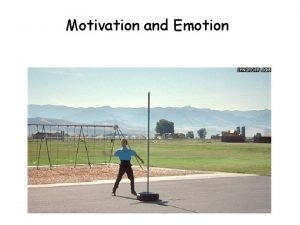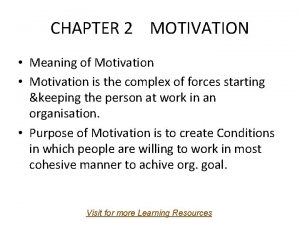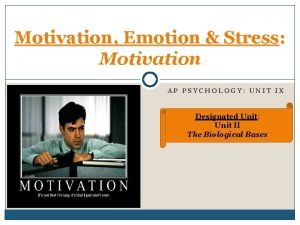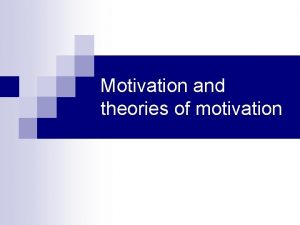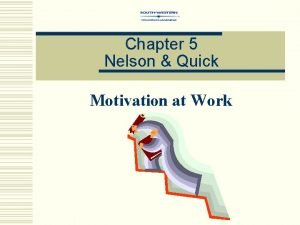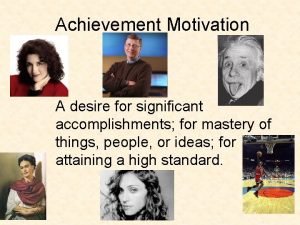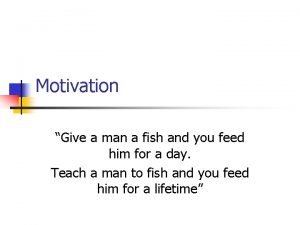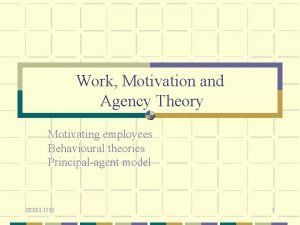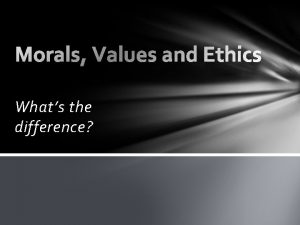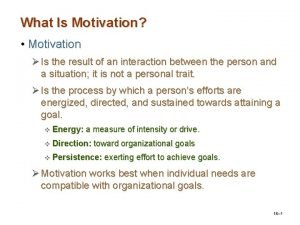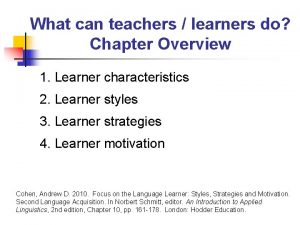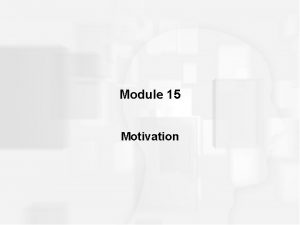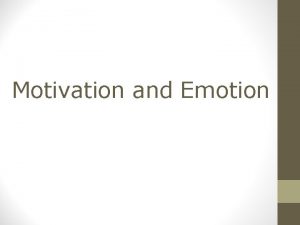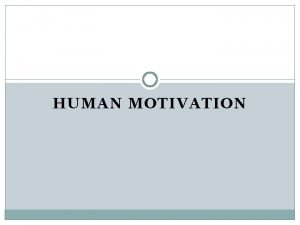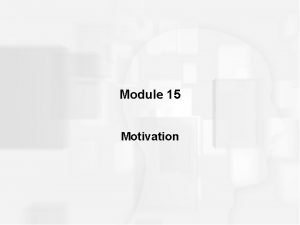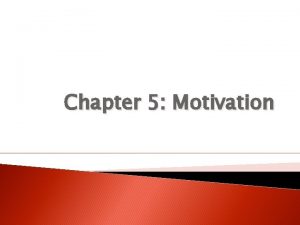Motivation Definition of Motivation l l Motivation is






















- Slides: 22

Motivation

Definition of Motivation l l Motivation is typically defined as the forces that account for the arousal, selection, direction, and continuation of behavior Motivation is the set of reasons that determines one to engage in a particular behavior

Motivating l l Everyone is motivated by different things and some of these factors are not money orientated: Employees might react more effectively to incentives that offer personal recognition and achievement. Motivation is based on individual needs, not external influences. When an individual himself wants to do something for his needs, motivation occurs automatically. Therefore, management should consider the relationship between the individual's needs and business to increase the individual's motivation at work Since motivation influences production, administrators need to understand what motivates workers to reach peak performance

Theory X l Management assumes employees are inherently lazy and will avoid work if they can l Workers inherently dislike work. Because of this, workers need to be closely supervised and comprehensive systems of controls developed. .

Theory X l Theory X manager: l tends to believe that everything must end in blaming someone. He or she thinks all prospective employees are only out for themselves. l Usually feel the sole purpose of the employees interest in the job is money. They will blame the person first in most situations, without questioning whether it may be the system, policy, or lack of training that deserves the blame. l cannot trust any employee, and they reveal this to their support staff via their communications constantly. l can be said to be an impediment to employee morale and productivity. Managers that subscribe to Theory X, tend to take a rather pessimistic view of their employees. l believes that his or her employees do not really want to work, that they would rather avoid responsibility and that it is the manager's job to structure the work and energize the employee.

Theory X l The result of this line of thought is that Theory X managers naturally adopt a more authoritarian style based on the threat of punishment. l One major flaw of this management style is it is much more likely to cause Diseconomies of Scale in large businesses.

Theory Y l management assumes employees may be ambitious, selfmotivated, anxious to accept greater responsibility, and exercise self-control, self-direction, autonomy and empowerment. l It is believed that employees enjoy their mental and physical work duties. l It is also believed that if given the chance employees have the desire to be creative and forward thinking in the workplace. l There is a chance for greater productivity by giving employees the freedom to perform at the best of their abilities without being bogged down by rules.

Theory Y l Theory Y manager: l l believes that, given the right conditions, most people will want to do well at work and that there is a pool of unused creativity in the workforce. l They believe that the satisfaction of doing a good job is a strong motivation in and of itself. l Will try to remove the barriers that prevent workers from fully actualizing themselves. Mc. Gregor simply argues for managers to be open to a more positive view of workers and the possibilities that this creates.

Maslow’s Hierarchy of Needs l l Abraham Maslow developed a theory of motivation that includes his famous hierarchy of needs: Survival, Safety, Social, Esteem and Self. Actualization. Maslow's theory states that until you satisfy the lower needs — starting with Survival — you cannot move forward through the other needs to achieve Self-Actualization.

MASLOW'S HIERARCHY OF NEEDS

1. Physiological Needs l l l These are biological needs. They consist of needs for oxygen, food, water, and a relatively constant body temperature. They are the strongest needs because if a person were deprived of all needs, the physiological ones would come first in the person's search for satisfaction.

Level 1 - Surviving l l l viewing life in a very inexperienced way, seeking survival at any cost. People who see the world through a Surviving perspective cannot handle the complexities of modern society People operating primarily at the Surviving perspective live on the fringes of society, in primitive cultures, or those who are institutionalized for anti-social behaviors. They cannot see the larger picture or understand the larger rhyme or reason to life. Even though we may be older souls, if we don’t have the basics needed to sustain physical life, we will act from the Surviving perspective until those basic needs are met. If we are starving to death, we will feel unable to cope with life in a more sophisticated way.

2. Safety Needs l l l When all physiological needs are satisfied and are no longer controlling thoughts and behaviors, the needs for security can become active. Adults have little awareness of their security needs except in times of emergency or periods of disorganization in the social structure (such as widespread rioting). Children often display the signs of insecurity and the need to be safe.

Level 2 - Safety Needs l Rule-making - viewing life through the limits of rules and structure for the protection of humans similar to the viewpoint of children. l For people operating primarily at the Rule-making perspective, life is very simplistic and follows a rather rigid pattern. Without rules, structure and order that provide them with safe operating guidelines, people focused at this perspective become very fearful. At this perspective, following the rules is most important, to the point of aggressively defending what is “right” or attacking those who do not follow the rules. When not following rules, people at this perspective are excellent at making rules, expecting everyone else to follow the same rules and act in the same way. As with the Surviving perspective regardless of our soul age, if we are cold, homeless and afraid without knowing how to get help or suddenly thrown into a foreign situation, we will operate from the view of solving our basic safety and protection needs. From this perspective, we are not able to see the larger picture or know that we are ultimately safe. l l

3. Needs of Love, Affection and Belongingness l l l When the needs for safety and for physiological well-being are satisfied, the next class of needs for love, affection and belongingness can emerge. Maslow states that people seek to overcome feelings of loneliness and alienation. This involves both giving and receiving love, affection and the sense of belonging.

Level 3 - Social Needs l l Competing - which means viewing life as competition with others, similar to teenagers who are striking out to conquer the world yet very dependent on their peer groups for respect and acceptance. At this perspective, the focus is on making money, becoming a success, attending the “popular” schools, having the most beautiful body or career - typical “Yuppie” culture focus. Regardless of our soul age, if we do not feel successful or accepted by our peers, we are operating from this need. Everyone has basic needs for support and respect from others that we care about. Babies who are not given love will die. Children, adolescents or adults who do not have love, respect and acceptance from someone will not survive very long.

4. Needs for Esteem l l When the first three classes of needs are satisfied, the needs for esteem can become dominant. T hese involve needs for both self-esteem and for the esteem a person gets from others. Humans have a need for a stable, firmly based, high level of selfrespect, and respect from others. When these needs are satisfied, the person feels self-confident and valuable as a person in the world. When these needs are frustrated, the person feels inferior, weak, helpless and worthless.

Level 4 - Esteem Needs l l l Relating, which means viewing life through a focus on relating to others. This perspective corresponds to someone moving into a “family” or “partnership” orientation where cooperation and trust become much more important than the individual’s needs. This perspective carries a strong recognition that we cannot do it alone - that we need other people to help us. As people recognize the need to be involved with others, they also question their own worth as individuals. In the Competing perspective, the person is concerned only with their own needs as an individual and does not look inside or consider their place as part of a group or a team. As they move to the Relating focus, they begin to compare themselves to others in a different way and seek to hold up their part of a group or in a relationship, rather than trying to stand out themselves.

Level 4 - Esteem Needs l l Often people become so focused on the group needs that they lose sight of their own needs leading to great confusion. At the Relating perspective, it is so hard for people to step out of their relationship issues that any disagreement or conflict can become a drama, consuming their energy until it is resolved. This is part of learning how to work with others and learning how to establish appropriate boundaries - a very important part of achieving self-esteem. The United States has been primarily a Competing culture focused on extreme competition with everyone and everything, now moving into a more Relating orientation. This shift in perspective accounts for the stronger focus on partnership and working together in business and international affairs. This shift in focus has been greatly enhanced by our presidential team (Bill & Hilary Clinton, Al & Tipper Gore - all mature souls) and their focus on health care and government programs benefiting everyone. It also accounts for the great interest by many people in the private lives of celebrities and ordinary folks alike. People are trying to understand their own lives by looking at how others do it.

5. Needs for Self-Actualization l l When all of the foregoing needs are satisfied, then and only then are the needs for self-actualization activated. Maslow describes self-actualization as a person's need to be and do that which the person was "born to do. " "A musician must make music, an artist must paint, and a poet must write. " These needs make themselves felt in signs of restlessness. The person feels on edge, tense, lacking something, in short, restless. If a person is hungry, unsafe, not loved or accepted, or lacking self-esteem, it is very easy to know what the person is restless about. It is not always clear what a person wants when there is a need for self-actualization.

Level 5 - Self-Actualization Needs l l Teaching - viewing life with more objectivity, wisdom, tolerance, acceptance, teaching others and seeing life as a broader vision of possibility. At the Teaching perspective, people are somewhat detached from the drama of the Relating perspective and view the Competing perspective with the tolerance of parents for their teenagers. They are more interested in philosophical pursuits, deep introspective work or learning how to connect with their higher power through whatever means may be available. People at this perspective are not concerned as much about success as defined in the outer world as they are concerned with how they feel about themselves and their worth to their selected tribal group. A person at the Teaching perspective may develop a definition of success that is based on comparing themselves to their own selfdefined goals, rather than the outer culture’s measure of success. They may be poor gardeners yet immensely happy with that slow pace of life. They may choose to create a successful business that helps them teach their views to others. Or, they may be anything in between.

Team work l l The VP Of operations would like to your team to complete a project that will require you to work through the weekend. You will need 2 engineers, 2 technicians, the warehouse supervisor and 2 warehouse employees. How would you go about recruiting each of them for your project? Break into teams and discuss your options.
 Motivation definition by psychologists
Motivation definition by psychologists Objective motivation
Objective motivation Motivation theories in organisational behaviour
Motivation theories in organisational behaviour Définition de la motivation
Définition de la motivation Instinct theory inside out
Instinct theory inside out Indirect characterization
Indirect characterization Character motivation definition
Character motivation definition Definition of motivation
Definition of motivation Nach psychology definition
Nach psychology definition Ap psychology motivation and emotion
Ap psychology motivation and emotion Non financial motivators
Non financial motivators Arousal theory of motivation example
Arousal theory of motivation example Motivation definition
Motivation definition Achievement motivation definition
Achievement motivation definition Définition de la motivation
Définition de la motivation Definition of motivation
Definition of motivation Motivation definition wikipedia
Motivation definition wikipedia Prärational
Prärational Agency theory of motivation
Agency theory of motivation Work improvement team
Work improvement team Motivation based on ideas of right and wrong
Motivation based on ideas of right and wrong How to define motivation
How to define motivation Gardner's motivation theory
Gardner's motivation theory




